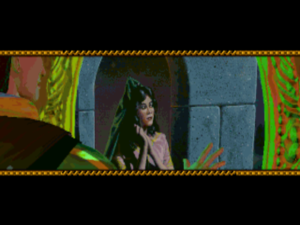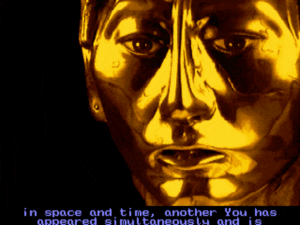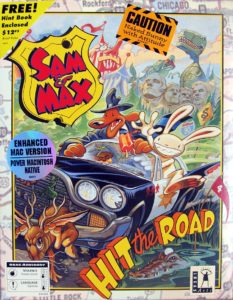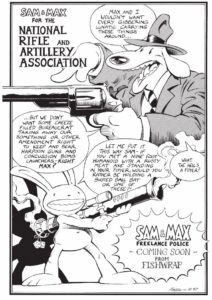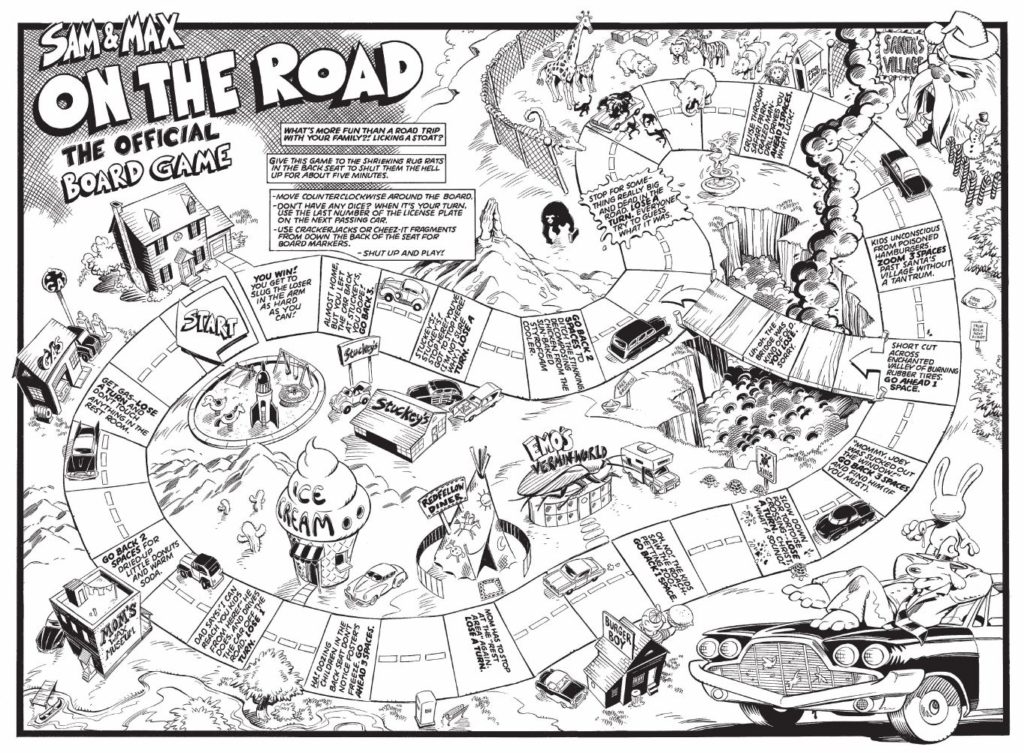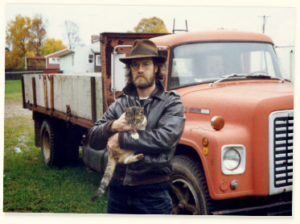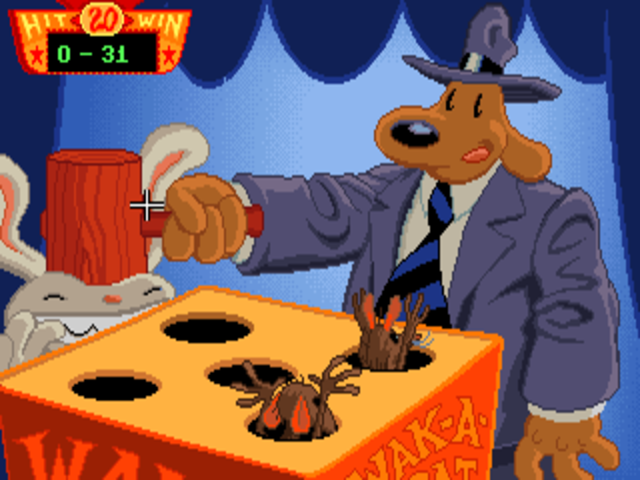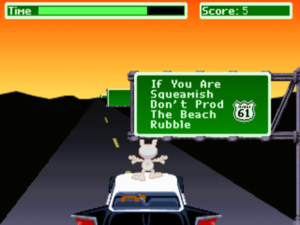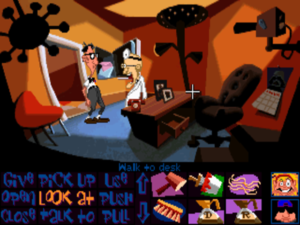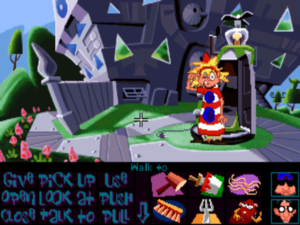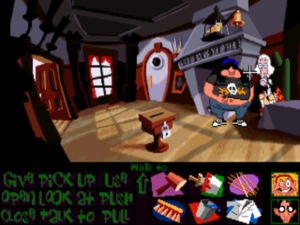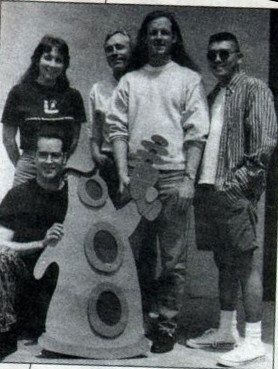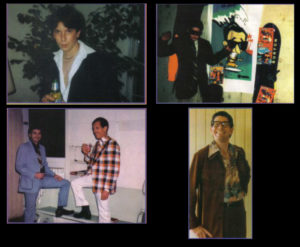
The Sierra Online of the 1980s and very early 1990s excelled at customer relations perhaps more than anything else. Through the tours of their offices (which they offered to anyone who cared to make the trip to rural Oakhurst, California), the newsletter they published (which always opened with a folksy editorial from their founder and leader Ken Williams), and their habit of grouping their games into well-delineated series with predictable content, they fostered a sense of loyalty and even community which other game makers, not least their arch-rivals over at LucasArts, couldn’t touch — this even though the actual games of LucasArts tended to be much better in design terms. Here we see some of the entrants in a Leisure Suit Larry lookalike contest sponsored by Sierra. (Yes, two of the contestants do seem suspiciously young to have played a series officially targeted at those 18 and older.) Sadly, community-building exercises like these would become increasingly rare as the 1990s wore on and Sierra took on a different, more impersonal air. This article will chronicle the beginning of those changes.
“The computer-game industry has become the interactive-entertainment industry.”
— Ken Williams, 1992
Another even-numbered year, another King’s Quest game. Such had been the guiding rhythm of life at Sierra Online since 1986, and 1992 was to be no exception. Why should it be? Each of the last several King’s Quest installments had sold better than the one before, as the series had cultivated a reputation as the premier showcase of bleeding-edge computer entertainment. Once again, then, Sierra was prepared to pull out all the stops for King’s Quest VI, prepared to push its development budget to $1 million and beyond.
This time around, however, there were some new and worrisome tensions. Roberta Williams, Sierra’s star designer, whose name was inseparable from that of King’s Quest itself in the minds of the public, was getting a little tired of playing the Queen of Daventry for the nation’s schoolchildren. She had another, entirely different game she wanted to make, a sequel to her 1989 mystery starring the 1920s girl detective Laura Bow. So, a compromise was reached. Roberta would do Laura Bow in… The Dagger of Amon Ra and King’s Quest VI simultaneously by taking a sort of “executive designer” role on both projects, turning over the nitty-gritty details to assistant designers.
Thus for the all-important King’s Quest VI, Sierra brought over Jane Jensen, who was fresh off the task of co-designing the rather delightful educational adventure EcoQuest: The Search for Cetus with Gano Haine. Roberta Williams described her working relationship with her new partner in a contemporary interview, striking a tone that was perhaps a bit more condescending than it really needed to be in light of Jensen’s previous experience, and that was oddly disparaging toward Sierra’s other designers to boot:
I took on a co-designer for a couple of reasons: I wanted to train Jane because I didn’t want Sierra to be dependent on me. Someone else needs to know how to do a “proper” adventure game. We’re all doing a good job from a technology standpoint, but not on design. In my opinion, the best way to learn it properly is side by side. Overall, it was a positive experience, and it was very good for the series because Jane brought in some new ideas. She learned a lot, too, and can take what she’s learned to help create her new games.
There’s something of a consensus among fans today that the result of this collaboration is the best overall King’s Quest of them all. This strikes me as a fair judgment. While it’s not a great adventure game by any means, King’s Quest VI: Heir Today, Gone Tomorrow isn’t an outright poor one either in terms of writing or design, and this is sufficient for it to clear the low bar of the previous games in the series. The plot is still reliant on fairy-tale clichés: a princess imprisoned in a tower, a prince who sets out to rescue her, a kingdom in turmoil around them. Yet the writing itself is more textured and coherent this time around, the implementation is far more complete (most conceivable actions yield custom messages of some sort in response), the puzzles are generally more reasonable, and it’s considerably more difficult than it was in the earlier games to wander into a walking-dead situation without knowing it. Evincing a spirit of mercy toward its players of a sort that Sierra wasn’t usually known for, it even has a branching point where you can choose from an easier or a harder pathway to the end of the game. And when you do get to the final scene, there are over a dozen possible variants of the ending movie, depending on the choices you’ve made along the way. Again, this degree of design ambition — as opposed to audiovisual ambition — was new to the series at the time.
The fans often credit this relative improvement completely to Jensen’s involvement. And this judgment as well, unkind though it is toward Roberta Williams, is not entirely unfounded, even if it should be tempered by the awareness that Jensen’s own later games for Sierra would all have significant design issues of their own. Many of the flaws that so constantly dogged Roberta’s games in particular were down to her insistence on working at a remove from the rest of the people making them. Her habit was to type up a design document on her computer at home, then give it to the development team with instructions to “call if you have any questions.” For all practical purposes, she had thus been working as an “executive designer” long before she officially took on that role with King’s Quest VI. This method of working tended to result in confusion and ultimately in far too much improvisation on the part of her teams. Combined with Sierra’s overarching disinterest in seeking substantive feedback from players during the development process, it was disastrous more often than not to the finished product. But when the time came for King’s Quest VI, Jane Jensen was able to alleviate at least some of the problems simply by being in the same room with the rest of the team every day. It may seem unbelievable that this alone was sufficient to deliver a King’s Quest that was so markedly better than any of the others — but, again, it just wasn’t a very high bar to clear.
For all that it represented a welcome uptick in terms of design, Sierra’s real priority for King’s Quest VI was, as always for the series, to make it look and sound better than any game before. They were especially proud of the opening movie, which they outsourced to a real Hollywood animation studio to create on cutting-edge graphics workstations. When it was delivered to Sierra’s offices, the ten-minute sequence filled a well-nigh incomprehensible 1.2 GB on disk. It would have to be cut down to two minutes and 6 MB for the floppy-disk-based release of the game. (It would grow again to six minutes and 60 MB for the later CD-ROM release.) A real showstopper in its day, it serves today to illustrate how Sierra’s ambitions to be a major media player were outrunning their aesthetic competencies; even the two-minute version manages to come off as muddled and overlong, poorly framed and poorly written. In its time, though, it doubtless served its purpose as a graphics-and-sound showcase, as did the game that followed it.
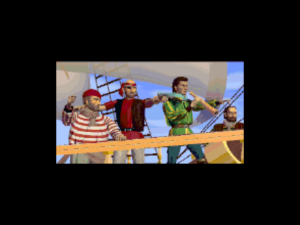
My favorite part of the much-vaunted King’s Quest VI introductory movie are the sailors that accompany Prince Alexander on his quest to rescue Princess Cassima. All sailors look like pirates, right?
A more amusing example of the company’s media naiveté is the saga of the King’s Quest VI theme song. Sierra head Ken Williams, who like many gaming executives of the period relished any and all linkages between games and movies, came up with the idea of including a pop song in the game that could become a hit on the radio, a “Glory of Love” or “I Will Always Love You” for his industry. Sierra’s in-house music man Mark Seibert duly delivered a hook-less dirge of a “love theme” with the distressingly literal title of “Girl in the Tower,” then hired an ersatz Michael Bolton and Celine Dion to over-emote it wildly. Then, Sierra proceeded to carpet-bomb the nation’s radio stations with CD singles of the song, whilst including an eight-page pamphlet in every copy of the game with the phone numbers for all of the major radio stations and a plea to call in and request it. Enough of Sierra’s loyal young fans did so that many a program director called Ken in turn to complain about his supremely artificial “grass-roots” marketing strategy. His song was terrible, they told him (correctly), and sometimes issued vague legal threats regarding obscure Federal Communications Commission laws he was supposedly violating. Finally, Ken agreed to pull the pamphlet from future King’s Quest VI boxes and accept that he wasn’t going to become a music as well as games impresario. Good Taste 1, Sierra 0. Rather hilariously, he was still grousing about the whole episode years later: “In my opinion, the radio stations were the criminals for ignoring their customers, something I believe no business should ever do. Oh, well… the song was great.”
While King’s Quest VI didn’t spawn a hit single, it did become a massive hit in its own right by the more modest sales standards of the computer-games industry. In fact, it became the first computer game in history to be certified gold by the Software Publishers Association — 100,000 copies sold — before it had even shipped, thanks to a huge number of pre-orders. Released in mid-October of 1992, it was by far the hottest game in the industry that Christmas, with Sierra struggling just to keep up with demand. Estimates of its total sales vary widely, but it seems likely that it sold 300,000 copies in all at a minimum, and quite possibly as many as 500,000 copies.
Despite its immediate success, King’s Quest VI was a mildly frustrating project for Sierra in at least one way. Everyone there agreed that this game, more so than any of the others they had made before, was crying out for CD-ROM, but too few consumers had CD-ROM drives in their computers in 1992 to make it worthwhile to ship the game first in that format. So, it initially shipped on nine floppy disks instead. Once decompressed onto a player’s hard drive, it filled over 17 MB — this at a time when 40 MB was still a fairly typical hard-disk size even on brand-new computers. Sierra recommended that players delete the 6 MB opening movie from their hard disks after watching it a few times just to free up some space. With stopgap solutions like this in play, there was a developing sense that something had to give, and soon. Peter Spears, author of an official guide to the entire King’s Quest series, summed up the situation thusly:
King’s Quest VI represents a fin de siecle, the end of an era. It is a game that should have been — needed to be — first published on CD-ROM. For all of its strengths and gloss, it is ill-served being played from a hard drive. If only because of its prominence in the world of computer entertainment, King’s Quest VI is proof that the era of CD playing is upon us.
Why? It is because imagination has no limits, and current hardware does. There are other games proving this point today, but King’s Quest has always been the benchmark. It is the end of one era, and when it is released on CD near the beginning of next year, it should be the beginning of another. Kill your hard drives!
Sierra had been evangelizing for CD-ROM for some time by this point, just as they earlier had for the graphics cards and sound cards that had transformed MS-DOS computers from dull things suitable only for running boring business applications into the only game-playing computers that really mattered in the United States. But, as with those earlier technologies, consumer uptake of CD-ROM had been slower than Sierra, chomping at the bit to use it, would have liked.
Thankfully, then, 1993 was the year when CD-ROM, a technology which had been around for almost a decade by that point, finally broke through; this was the year when the hardware became cheap enough and the selection of software compelling enough to power a new wave of multimedia excitement which swept across the world of computing. As with those graphics cards and sound cards earlier on, Sierra’s relentless prodding doubtless played a significant role in this newfound consumer acceptance of CD-ROM. And not least among the prods was the CD-ROM version of King’s Quest VI, which boasted lusher graphics in many places and voices replacing text absolutely everywhere. The voice acting marked a welcome improvement over the talkie version of King’s Quest V, the only previous game in the series to get a release on CD-ROM. The fifth game had apparently been voiced by whoever happened to be hanging around the office that day, with results that were almost unlistenably atrocious. King’s Quest VI, on the other hand, got a professional cast, headed by Robby Benson, who had just played the male protagonist in the hit Disney cartoon of Beauty and the Beast. Although Sierra could all too often still seem like babes in the woods when it came to media aesthetics, they were slowly learning on at least some fronts.
In the meantime, they could look to the bottom line of CD-ROM uptake with satisfaction. They shipped just 13 percent of their products on CD-ROM in 1992; in 1993, that number rose to 36 percent. Already by the end of that year, they had initiated their first projects that were earmarked only for CD-ROM. The dam had burst; the floppy disk was soon to be a thing of the past as a delivery medium for games.
This ought to have been a moment of unabashed triumph for Sierra in more ways than one. Back in the mid-1980s, when the company had come within a whisker of being pulled under by the Great Home Computer Crash, Ken Williams had decided, against the conventional wisdom of the time, that the long-term future of consumer computing lay with the operating systems of Microsoft and the open hardware architecture inadvertently spawned by the original IBM PC. He’d stuck to his guns ever since; while Sierra did release some of their games for other computer platforms, they were always afterthoughts, mere ways to earn a little extra money while waiting for the real future to arrive. And now that future had indeed arrived; Ken Williams had been proved right. The monochrome cargo vans of 1985 had improbably become the multimedia sports cars of 1993, all whilst sticking to the same basic software and hardware architecture.
And yet Ken was feeling more doubtful than triumphant. While he remained convinced that CDs were the future of game delivery, he was no longer so convinced that MS-DOS was the only platform that mattered. On the contrary, he was deeply concerned by the fact that, while MS-DOS-based computers had evolved enormously in terms of graphics and sound and sheer processing power, they remained as cryptically hard to use as ever. Just installing and configuring one of his company’s latest games required considerable technical skill. His ambition, as he told anyone who would listen, was to build Sierra into a major purveyor of mainstream entertainment. Could he really do that on MS-DOS? Yes, Microsoft Windows was out there as well — in fact, it was exploding in popularity, to the point that it was already becoming hard to find productivity software that wasn’t Windows-based. But Windows had its own fair share of quirks, and wasn’t really designed for running high-performance games under any circumstances.
Even as MS-DOS and Windows thus struggled with issues of affordability, approachability, and user-friendliness in the context of games, new CD-based alternatives to traditional computers were appearing almost by the month. NEC and Sega were selling CD drives as add-ons for their TurboGrafx-16 and Genesis game consoles; Philips had something called CD-i; Commodore had CDTV; Trip Hawkins, founder of Electronic Arts, had split away from his old company to found 3DO; even Tandy was pushing a free-standing CD-based platform called the VIS. All of these products were designed to be easy for ordinary consumers to operate in all the ways a personal computer wasn’t, and they were all designed to fit into the living room rather than the back office. In short, they looked and operated like mainstream consumer electronics, while personal computers most definitely still did not.
But even if one assumed that platforms like these were the future of consumer multimedia, as Ken Williams was sorely tempted to do, which one or two would win out to become the standard? The situation was oddly similar to that which had faced software makers like Sierra back in the early 1980s, when the personal-computer marketplace had been fragmented into more than a dozen incompatible platforms. Yet the comparison only went so far: development costs for the multimedia software of the early 1990s were vastly higher, and so the stakes were that much higher as well.
Nevertheless, Ken Williams decided that the only surefire survival strategy for Sierra was to become a presence on most if not all of the new platforms. Just as MS-DOS had finally, undeniably won the day in the field of personal computers, Sierra would ironically abandon their strict allegiance to computers in general. Instead, they would now pledge their fealty to CDs in the abstract. For Ken had grander ambitions than just being a major player on the biggest computing platform; he wanted to be a major player in entertainment, full stop. “Sierra is an entertainment company, not a software company,” he said over and over.
So, at no inconsiderable expense, Ken instituted projects to port the SCI engine that ran Sierra’s adventure games to most of the other extant platforms that used CDs as their delivery medium. In doing so, however, he once again ran into a problem that Sierra and other game developers of the early 1980s, struggling to port their wares to the many incompatible platforms of that period, had become all too familiar with: the fact that every platform had such different strengths and weaknesses in terms of interface, graphics, sound, memory, and processing potential. Just because a platform of the early 1990s could accept software distributed on CD didn’t mean it could satisfactorily run all of the same games as an up-to-date personal computer with a CD-ROM drive installed. Corey Cole, who along with his wife Lori Ann Cole made up Sierra’s most competent pair of game designers at the time, but who was nevertheless pulled away from his design role to program a port of the SCI engine to the Sega Genesis with CD drive:
The Genesis CD system was essentially identical to the Genesis except for the addition of the CD. It had inadequate memory for huge games such as the ones Sierra made, and it could only display 64 colors at a time from a 512 color palette. Sierra games at the time used 256 colors at a time from a 262,144 color palette. So the trick became how to make Sierra games look good in a much smaller color space.
Genesis CD did supply some tricks that could be used to fake an expanded color space, and I set out to use those. The problem was that the techniques I used required a lot of memory, and the memory space on the Genesis was much smaller than we expected on PCs at the time. One of the first things I did was to put a memory check in the main SCI processing loop that would warn me if we came close to running out of memory. I knew it would be close.
Sierra assigned a programmer from the Dynamix division to work with me. He had helped convert Willy Beamish to the Genesis CD, so he understood the system requirements well. However, he unintentionally sabotaged the project. In his early tests, my low-memory warning kicked in, so he disabled it. Six months later, struggling with all kinds of random problems (the hard-to-impossible kind to fix), I discovered that the memory check was disabled. When I turned it back on, I learned that the random bugs were all caused by insufficient memory. Basically, Sierra games were too big to fit on the Genesis CD, and there was very little we could do to shoehorn them in. With the project now behind schedule, and the only apparent solution being a complete rewrite of SCI to use a smaller memory footprint, Sierra management cancelled the project.
While Corey Cole spun his wheels in this fashion, Lori Ann Cole was forced to design most of Quest for Glory III alone, at significant cost to this latest iteration in what had been Sierra’s most creative and compelling adventure series up to that point.
The push to move their games to consoles also cost Sierra in the more literal sense of dollars and cents, and in the end they got absolutely no return for their investment. Some of the porting projects, like the one on which Corey worked, were abandoned when the target hardware proved itself not up to the task of running games designed for cutting-edge personal computers. Others were rendered moot when the entire would-be consumer-electronics category of multimedia set-top boxes for the living room — a category that included CD-i, CDTV, 3DO, and VIS — flopped one and all. (Radio Shack employees joked that the VIS acronym stood for “Virtually Impossible to Sell.”) In the end, King’s Quest VI never came out in any versions except those for personal computers. Ken Williams’s dream of conquering the living room, like that of conquering the radio waves, would never come to fruition.
The money Sierra wasted on the fruitless porting projects were far from the only financial challenge they faced at the dawn of the CD era in gaming. Although everyone at the company had chafed against the restrictions of floppy disks, those same restrictions had, by capping the amount of audiovisual assets one could practically include in a game, acted as a restraint on escalating development budgets. With CD-ROM, all bets were off in terms of how big a game could become. Sierra felt themselves to be in a zero-sum competition with the rest of their industry to deliver ever more impressive, ever more “cinematic” games that utilized the new storage medium to its full potential. The problem, of course, was that such games cost vastly more money to make.
It was a classic chicken-or-the-egg conundrum. Ken Williams was convinced that games had the potential to appeal to a broader demographic and thus sell in far greater numbers than ever before in this new age of CD-ROM. Yet to reach that market he first had to pay for the development of these stunning new games. Therein lay the rub. If this year’s games cost less to make but also come with a much lower sales cap than next year’s games, the old financial model — that of using the revenue generated by this year’s games to pay for next year’s — doesn’t work anymore. Yet to scale back one’s ambitions for next year’s games means to potentially miss out on the greatest gold rush in the history of computer gaming to date.
As if these pressures weren’t enough, Sierra was also facing the slow withering of what used to be another stable source of revenue: their back catalog. In 1991, titles released during earlier years accounted for fully 60 percent of their sales; in 1992, that number shrank to 48 percent, and would only keep falling from there. In this new multimedia age, driven by audiovisuals above all else, games that were more than a year or two old looked ancient. People weren’t buying them, and stores weren’t interested in stocking them. (Another chicken-or-the-egg situation…) This forced a strike-while-the-iron-is-hot mentality toward development, increasing that much more the perceived need to make every game look and sound spectacular, while also instilling a countervailing need to release it quickly, before it started to look outdated. Sierra had long been in the habit of amortizing their development costs for tax and other accounting purposes: i.e., mortgaging the cost of making each game against its future revenue. Now, as the size of these mortgages soared, this practice created still more pressure to release each game in the quarter to which the accountants had earmarked it. None of this was particularly conducive to the creation of good, satisfying games.
At first blush, one might be tempted to regard what came next as just more examples of the same types of problems that had always dogged Sierra’s output. Ken Williams had long failed to instill the culture and processes that consistently lead to good design, which had left well-designed games as the exception rather than the rule even during the company’s earlier history. Now, though, things reached a new nadir, as Sierra began to ship games that were not just poorly designed but blatantly unfinished. Undoubtedly the most heartbreaking victim of these pressures was Quest for Glory IV, Corey and Lori Ann Cole’s would-be magnum opus, which shipped on December 31, 1993 — the last day of the fiscal quarter to which it had been earmarked — in a truly woeful condition, so broken it wasn’t even possible to complete it. Another sorry example was Outpost, a sort of SimCity in space that was rendered unplayable by bugs. And an even worse one was Alien Legacy, an ambitious attempt to combine strategy with adventure gaming in a manner reminiscent of Cryo Interactive’s surprisingly effective adaptation of Dune. We’ll never know how well Sierra’s take on the concept would have worked because, once again, it shipped unfinished and essentially unplayable.
Each of these games had had real potential if they had only been allowed to realize it. One certainly didn’t need to be an expert in marketing or anything else to see how profoundly unwise it was in the long run to release them in such a state. While each of them met an arbitrary accounting deadline, thus presumably preventing some red ink in one quarter, Sierra sacrificed long-term profits on the altar of this short-term expediency: word quickly got around among gamers that the products were broken, and even many of those who were unfortunate enough to buy them before they got the word wound up returning them. That Sierra ignored such obvious considerations and shoved the games out the door anyway speaks to the pressures that come to bear as soon as a company goes public, as Sierra had done in 1988. Additionally, and perhaps more ominously, it speaks to an increasing disconnect between management and the people making the actual products.
Through it all, Ken Williams, who seemed almost frantic not to miss out on what he regarded as the inflection point for consumer software, was looking to expand his empire, looking to make Sierra known for much more than adventure games. In fact, he had already begun that process in early 1990, when Sierra acquired Dynamix, a development house notable for their 3D-graphics technology, for $1 million in cash and some stock shenanigans. That gambit had paid off handsomely; Dynamix’s World War II flight simulator Aces of the Pacific became Sierra’s second biggest hit of 1992, trailing only the King’s Quest VI juggernaut whilst — and this was important to Ken — appealing to a whole different demographic from their adventure games. In addition to their flight simulators, Dynamix also spawned a range of other demographically diverse hits over this period, from The Incredible Machine to Front Page Sports: Football.
With a success story like that in his back pocket, it was time for Ken to go shopping again. In July of 1992, Sierra acquired Bright Star Technology, a Bellevue, Washington-based specialist in educational software, for $1 million. Ken was convinced that educational software, a market that had grown only in fits and starts during earlier years, would become massive during the multimedia age, and he was greatly enamored with Bright Star’s founder, a real bright spark himself named Elon Gasper. “He thinks, therefore he is paid,” was Ken’s description of Gasper’s new role inside the growing Sierra. Bright Star also came complete with some innovative technology they had developed for syncing recorded voices to the mouths of onscreen characters — perhaps not the first problem one thinks of when contemplating a CD-ROM-based talkie of an adventure game, but one which quickly presents itself when the actual work begins. King’s Quest VI became the first Sierra game to make use of it; it was followed by many others.
Meanwhile Bright Star themselves would deliver a steady stream of slick, educator-approved learning software over the years to come. Less fortunately, the acquisition did lead to the sad demise of Sierra’a in-house “Discovery Series” of educational products, which had actually yielded some of their best designed and most creative games of any stripe during the very early 1990s. Now, the new acquisition would take over responsibility for a “second, more refined generation of educational products,” as Sierra’s annual report put it. But in addition to being more refined — more rigorously compliant with established school curricula and the latest pedagogical theories — they would also be just a little bit boring in contrast to the likes of The Castle of Dr. Brain. Such is the price of progress.
Sierra’s third major acquisition of the 1990s was more complicated, more expensive, and more debatable than the first two had been. On October 29, 1993, they bought the French developer and publisher Coktel Vision for $4.6 million. Coktel had been around since 1985, unleashing upon European gamers such indelibly (stereotypically?) French creations as Emmanuelle: A Game of Eroticism, based on a popular series of erotic novels and films. But by the early 1990s, Coktel was doing the lion’s share of their business in educational software. In 1992, estimates were that 50 to 75 percent of the software found in French schools came from Coktel. The character known as Adi, the star of their educational line, is remembered to this day by a whole generation of French schoolchildren.
Sierra had cut a deal more than a year before the acquisition to begin distributing Coktel’s games in the United States, and had made a substantial Stateside success out of Gobliiins, a vaguely Lemmings-like puzzle game. That proof of concept, combined with Coktel’s educational line and distributional clout in Europe — Ken was eager to enter that sprawling market, where Sierra heretofore hadn’t had much of a footprint — convinced the founder to pull the trigger.
But this move would never quite pan out as he had hoped. Although the text and voices were duly translated, the cultural idiom of Adi just didn’t seem to make sense to American children. Meanwhile Coktel’s games, which mashed together disparate genres like adventure and simulation with the same eagerness with which they mashed together disparate presentation technologies like full-motion video and 3D graphics, encountered all the commercial challenges that French designs typically ran into in the United States. Certainly few Americans knew what to make of a game like Inca; it took place in the far future of an alternate history where the ancient Incan civilization had survived, conquered, and taken to the stars, where they continued to battle, Wing Commander-style, with interstellar Spanish galleons. (The phrase “what were they smoking?” unavoidably comes to mind…) Today, the games of Coktel are remembered by American players, if they’re remembered at all, mostly for the sheer bizarreness of premises like this one, married to puzzles that make the average King’s Quest game seem like a master class in good adventure design. Coktel’s European distribution network undoubtedly proved more useful to Sierra than the company’s actual games, but it’s doubtful whether even it was useful to the tune of $4.6 million.
Ken Williams was playing for keeps in a high-stakes game with all of these moves, as he continued to do as well with ImagiNation, a groundbreaking, genuinely visionary online service, oriented toward socializing and playing together, which stubbornly refused to turn a profit. All together, the latest moves constituted a major shift in strategy from the conservative, incrementalist approach that had marked his handling of Sierra since the company’s near-death experience of the mid-1980s. From 1987 — the year the recovering patient first managed to turn a profit again — through 1991, Sierra had sold more games and made more money each year. The first of those statements held true for 1992 as well, as sales increased from $43 million to within a whisker of $50 million. But profits fell off a cliff; Sierra lost almost $12.5 million that year alone. Sales increased impressively again in 1993, to $59.5 million. Yet, although the bottom line looked less ugly, it remained all too red thanks to all of the ongoing spending; the company lost another $4.5 million that year.
In short, Ken Williams was now mortgaging Sierra’s present against its future, in precisely the way he’d sworn he’d never do again during those dark days of 1984 and 1985. But he felt he had to make his play for the big time now or never; CD-ROM was a horse he just had to ride, hopefully all the way to the nerve center of Western pop culture. And so he did something else he’d sworn he would never do: he left Oakhurst, California. In September of 1993, Ken and Roberta and select members of Sierra’s management team moved to Bellevue, Washington, to set up a new “corporate headquarters” there; sales and marketing would gradually follow over the months to come. Ken had long been under pressure from his board to move to a major city, one where it would be easier to recruit a “first-rate management team” to lead Sierra into a bold new future. Bellevue, a suburb of Seattle that was close to Microsoft, Nintendo of America, and of course Sierra’s own new subsidiary of Bright Star, seemed as good a choice as any. Ken promised Sierra’s creative staff as well as their fans that nothing would really change: most of the games would still be made in the cozy confines of Oakhurst. And he spoke the truth — at least in literal terms, at least for the time being.
Nevertheless, something had changed. The old dream of starting a software company in the woods, the one which had brought a much younger, much shaggier Ken and Roberta to Oakhurst in 1980, had in some very palpable sense run its course. Sierra had well and truly gone corporate; Ken and Roberta were back in the world they had so consciously elected to escape thirteen years before. Oh, well… the arrows of both revenue and profitability at Sierra were pointing in the right direction. One more year, Ken believed, and they ought to be in the black again, and in a stronger position in the marketplace than ever at that. Chalk the rest of it up as yet one more price of progress.
(Sources: the book Influential Game Designers: Jane Jensen by Anastasia Salter; Sierra’s newsletter InterAction of Spring 1992, Fall 1992, Winter 1992, June 1993, Summer 1993, Holiday 1993, Spring 1994, and Fall 1994; The One of April 1989; ACE of May 1989; Game Players PC Entertainment of Holiday 1992; Compute! of May 1993; Computer Gaming World of January 1992; press releases, annual reports, and other internal and external documents from the Sierra archive at the Strong Museum of Play. An online source was the Game Nostalgia article on King’s Quest VI. And my thanks go to Corey Cole, who took the time to answer some questions about this period of Sierra’s history from his perspective as a developer there.)
